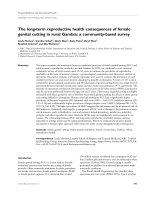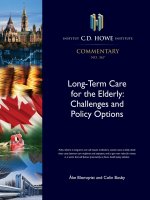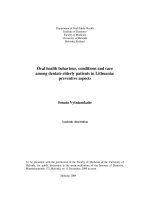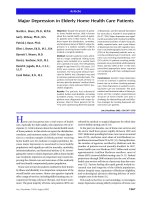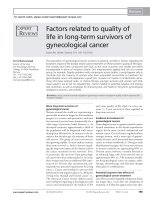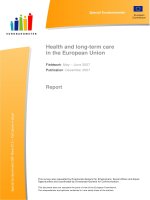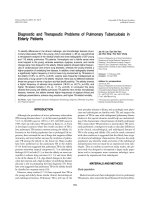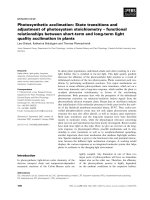LONG TERM FEEDING TUBE PLACEMENT IN ELDERLY PATIENTS pptx
Bạn đang xem bản rút gọn của tài liệu. Xem và tải ngay bản đầy đủ của tài liệu tại đây (411.71 KB, 23 trang )
Making Choices:
SL Mitchell MD MPH FRCPC Geriatric Medicine, Epidemiology
JM Tetroe MA Health Research
AM O’Connor RN PhD Nursing, Epidemiology
A Rostom MD FRCPC Gastroenterology, Epidemiology
C Villeneuve BSc RD Dietitian
B Hall RN BScN Geriatric Nursing
Division of Geriatric Medicine
Clinical Epidemiology Program
Ottawa Hospital – Civic Campus
Long Term Feeding Tube
Placement in Elderly Patients
Ottawa Health Research Institute
1053 Carling Ave
Ottawa Ontario K1Y 4E9
Canada
E-mail:
SL Mitchell:
2
A booklet and audio tape for substitute decision makers
Developer disclosure:
None of the developers or their institutional affiliations can
gain financially from the information contained within this
patient decision aid.
Developers:
©
Mitchell, Tetroe and O’Connor 2001 (updated 2008)
Welcome
This workbook and cassette tape have been designed to prepare
you for a decision about placing a feeding tube in an elderly
patient. As you go through the booklet and tape, you will learn
about substitute decision making as well as the advantages and
disadvantages of placing a feeding tube in your friend or family
member.
1. Set aside about 45 minutes
Regional Geriatric Assessment
Program
2. Listen to the cassette while reading
through the booklet.
3. Please stay on the page until you hear the
sound to turn to the next page.
4. Please fill out the worksheet.
Supported by a grant from Physician Services Incorporated.
Dr. Mitchell is a recipient of an Ontario Ministry of Health
Career Scientist Award
Research studies that support statements in this booklet are
referenced by numbers like this:
1
. The complete list of
references is at the back of the booklet, starting on page 37.
43
Table of Contents
Overview 5
Eating and Swallowing Problems 6
What is a “PEG” (gastric tube)? 9
Substitute Decision Making 13
Health Outcomes From Feeding Tubes 16
What Are My Treatment Choices? 23
What is Supportive Care? 24
Can Tube Feeding Be Discontinued? 26
Advantages and Disadvantages 27
How to Decide for Your Family Member: 6 Steps 28
Examples of How To Decide 31
References 37
Personal Worksheet for Feeding Tube Placement 42
This workbook is for you if:
• you are the substitute decision maker for an
older person who is currently unable to make
his/her own health care decisions
• you need to decide whether the person should have
a long term feeding tube known as a gastrostomy
tube (PEG) or a jejunostomy tube (j-tube)
• this workbook does not deal with the decision
to place very temporary feeding tubes called
nasogastric (NG) tubes
You will learn about:
• eating and swallowing problems
• feeding tubes
• substitute decision-making
• advantages and disadvantages of feeding tube
placement
• treatment options
• how to decide
5
6
Why do people develop eating and
swallowing problems?
Damage to the muscles and nerves needed for proper
swallowing,
Possible causes are:
• Stroke
• Parkinson’s disease
• Amyotrophic lateral sclerosis
(Lou Gehrig’s disease)
Inability to eat independently because of:
• Alzheimer’s disease
• other dementias
Blockage of the esophagus (the tube that goes from
the mouth to the stomach):
• cancer of the esophagus
• stricture
Severe loss of appetite or interest in eating:
major depression
How do eating and swallowing problems
affect older patients and those close to
them?
PHYSICAL
Aspiration: Food or saliva may be inhaled into the
lungs if the patient is very drowsy or if he has
problems with the nerves or muscles needed to
swallow. This may result in lung infections.
Poor nutrition: The patient will:
• become weaker
• lose weight
• become less aware of what is going on
• not recover as quickly from a sudden illness
Comfort
: A patient who is very aware may feel
hungry and thirsty. Patients who are not very aware
may not feel hunger or thirst
.
1
7
8
EMOTIONAL
Friends and family may find it difficult to accept a
patient’s serious illness. They may find it hard to see
a person close to them not eat enough. They might
feel worried that the patient may feel hunger or thirst.
SOCIAL
• Eating is social and symbolic of care giving.
• Helping a patient to eat can be a pleasant way to
interact with him or her
• If a patient cannot be hand fed, the family may feel
a loss of this personal interaction. However, other
ways of socializing with him or her are always
possible.
What is a percutaneous endoscopic
gastrostomy (PEG)* tube?
• A tube placed directly into the stomach of
someone with eating problems
• An optional medical treatment
• Percutaneous
– through the skin
• Endoscopic
– a doctor will put a tube with a
camera in it (an endoscope) down into the
patient’s stomach to help guide the tube into the
correct spot
• Gastrostomy
– a procedure where a tube is put into
the stomach through a small hole in the abdomen
* Another type of long-term feeding-tube called a
jejunostomy tube may be offered to your patient. The
procedure to place this tube differs slightly. You
should ask your doctor about this.
9
10
How is the tube put into place?
• The patient is mildly sedated (not put to sleep).
• The endoscope is placed through the mouth and
into the stomach. This can
be a bit uncomfortable, but
it does not hurt. It is
needed to see where the
best place is to put the tube.
• The patient is given a local
anaesthetic to freeze the
skin on the abdomen so
that a small cut can be
made. The tube is inserted
through the mouth and
pulled out through the
opening in the abdomen.
• This procedure takes about
15
minutes.
• Sometimes it is not possible to insert the
endoscope because the esophagus is blocked by a
growth or tumour. In these cases, the feeding tube
would be placed surgically.
How Does the person with the feeding
tube get their food?
• Liquid food is put into a bag and then delivered
into the stomach through a tube.
• The food is a commercially prepared liquid that
provides a balanced diet for the patient. It is
something like a milkshake.
• Most patients will be fed through the tube at usual
meal times. The
feeding will take about
one hour. Some
patients will receive
continuous feedings in
which the same
amount of food is
given, but at a slower
rate over 24 hours.
• Medications as well as water will also be given
through the tube.
10
11
What is involved in the care of the tube?
• Care must be taken not to pull out the tube.
• The nurse will check for tube leakage, blockage
and will make sure that the food is going in
properly.
• The nurse will clean around the tube at least once a
day and check the surrounding skin.
• The tube will usually need to be replaced within
six months to one year.
Will the person with a gastrostomy tube
have to stay in bed?
No, the tube is very portable. When the tube is not in
use, it will not restrict the patient’s usual activities.
What is “substitute decision making
2
”?
• deciding for others who are unable to make their own
health care decisions
• what the patient would want may not be the same as
what you would choose for yourself in the same
situation
• substitute decision making can be very difficult and
emotional
Who becomes a “substitute decision-
maker”?
• a person previously named by the patient (someone
who has power of attorney for health care)
• next-of-kin
• appointed guardian
12
13
What are the steps involved in substitute
decision making?
1) Consider the previously expressed wishes of the
patient from either:
• living will (sometimes called an “advance
directive”)
• previous discussions the patient had with you
and/or others
These wishes should be respected, even if you do not
agree with them.
2) Consider all you know about the values of your
patient when she was well. From what you know do
you think she would choose to get a feeding tube in
this situation or not? This is called “substituted
judgement”.
3) If there are no previously expressed wishes and you
cannot judge what your patient would want, consider
what is in his “best interests”.
• what are the possible advantages of tube feeding
• what are the possible disadvantages of tube
feeding
• how will this decision affect his quality of life
Can a feeding tube be placed without the
written consent of the substitute decision-
maker?
No
14
15
Possible health outcomes from Feeding
Tubes
Tube feeding is a medical treatment that can have a variety of
possible health outcomes or consequences.
These outcomes can be divided into two types:
• Specific complications from the feeding tube itself
• General health outcomes that most commonly come up in
discussions about feeding tubes, for example:
♦ survival
♦ aspiration (breathing in of food)
In the next few pages, we will talk about these outcomes so
that you can have a better understanding of the advantages,
disadvantages and other considerations about tube feeding.
Ranking studies about tube feeding
In order to learn about health outcomes, you need to
understand about the different types of research studies that can
be done. There are basically three kinds:
Randomized Trials
• whether or not someone gets a feeding tube is
based on a toss of a coin
• patients with a feeding tube are comparable to
patients without a feeding tube
• more confident in the results
(There are no randomized trials of tube feeding)
Non-Randomized Trials
• patients who have chosen to have feeding tubes
are compared to patients without feeding tubes
• tube fed patients may be different from patients
without feeding tubes in ways that may affect
the outcomes
• less confident in the results
Case Series
Gold
Silver
Bronze
A group of patients with feeding tubes are followed
over time to see how they do
16
17
Complications from feeding tube
placement
We have tried to summarize the studies for you so that you can
have some idea of the chances of your family member having a
complication. The numbers below are averages (taken from
articles published in medical journals) which vary from patient
to patient.
Type of Complication How many out of 100 *
patients might get it?
Infections
• minor (skin)
3,5-10
• major (life threatening)
4,5,8,9
4 out of 100
1 out of 100
Bleeding
• minor (no transfusion)
3,4,7
• major (need transfusion)
3,4,7
less than 1 out of 100
nearly 0 out of 100
Temporary diarrhea, cramping
3,5,9,11
Temporary vomiting, nausea
3,5,11
12 out of 100
9 out of 100
Tube problems
• minor (dislodgment, blockage,
leaking)
3-9
• major (perforation of
bowel)
3,4,6-8,10
4 out of 100
less than 1 out of 100
Death
• from putting the tube in
5,8,9
less than 1 out of 100
* These values are for PEG tubes only. The values may differ
for jejunostomy tubes.
Will putting in a feeding tube increase the
patient’s chance of survival?
There are no randomized trials comparing similar
patients with and without feeding tubes to see who
lived longer. Because of this, there is no
straightforward answer to this question of survival.
Gold
Silver
Bronze
Non-randomized trials in nursing homes have found
that tube fed patients do not live longer than similar
patients without feeding tubes. However, it is not clear
how long these patients would have lived if they had
never been given a feeding tube. It could be that
patients who are given tubes are sicker than patients
who are not given tubes.
It is difficult to predict how long your patient would
live with or without a tube. Case series of patients with
feeding tubes have shown that those with the following
characteristics have a shorter survival:
• very old patients (over 85 years)
7,10,20,23
• patients who tend to aspirate (breathe in) their food
10
• patients who are already very undernourished
7,15
• patients with a previous diagnosis of malignancy
20,23,33
18
19
How long can I expect my family member
to live?
This chart shows you how many out of 100 elderly patients
who have feeding tubes will still be alive in 30 days
4,5,7-
9,10,12,16-25
, 60 days
4,12,18,24,25
, 6 months
5,12,25
and 1 year
10,12,13,20,23
, after putting the tube in. The numbers on the chart
are averaged over many studies. It is difficult to know for sure
how long any one patient will live.
Prolonging life may or may not be what your family member
would want. This may depend on his quality of life and
personal values or beliefs.
What is aspiration and how does it affect
my family member?
0
10
20
30
40
50
60
70
80
90
100
1 day 30 days 60 days 6 months 1 year
number of patients out of 100 who will
survive
• aspiration means that the patient inhales or breathes food or
saliva into her lungs. This happens because the patient has
trouble swallowing.
• it can be an uncomfortable feeling for patients to
experience.
• It can also be dangerous because it can cause pneumonia,
an infection in the lungs.
Gold
There are no randomized trials comparing the chances
of aspiration in patients with and without feeding tubes.
Non randomized trials
14,26
comparing patients with and
without feeding tubes show that patients with tubes are
more likely to be aspirators. However, it is not clear
from the studies if getting a feeding tube increases the
chances of aspirating, or whether being an aspirator
increases the chances of getting a feeding tube.
Silver
It is clear from several case series
23,27,28
that putting in a
feeding tube will not necessarily stop a patient from
aspirating. More than half of patients in these studies
who aspirated before they were given a tube, still
aspirated after they were given a tube. On average, 16 out of
100 patients with a feeding tube will aspirate
3,6,7,10
.
Bronze
20
21
What other factors are important to
consider when deciding about placing a
feeding tube?
Stroke patients who have swallowing problems may
recover better if the feeding tube is placed earlier on
in their illness, rather than waiting a few weeks.
32
Patients who have been
totally unaware of their
surroundings and dependent on others to look after
their basic needs for several months are less likely to
improve, whether they have a feeding tube or not.
18
Whether or not a patient gets a feeding tube may
determine what
kind of facility he can live in. You
should discuss this with the health care team.
Some patients with feeding tubes may become
agitated and/or may try to pull the tube out. The
health care team may suggest restraints or medications
to stop the patient from doing this. As the substitute
decision-maker, you should be involved in this
decision. This should not happen without your
consent.
What are my treatment choices?
Because the person in your care is having eating
and/or swallowing problems, the health care team is
offering the choice of:
supportive care
plus
placement of a feeding tube
or
supportive care
22
23
What is supportive care?
Supportive care involves:
1. hand-feeding if possible
2. other treatments to keep the patient comfortable
1. Hand-feeding
• patients with eating problems who do not
receive a feeding tube may or may not be able
to be hand fed
• some patients with a feeding tube may also be
able to get some food by mouth
How is it decided if a patient can be hand-fed?
• members of the health care team (for example,
doctor, nurse, dietitian, speech and language
pathologist, occupational therapist) will decide
how safe it is to hand feed a patient
• a special swallowing study may be done to see
what consistency of food the patient can
tolerate easily
Who hand feeds the patient?
• trained health care professionals (nurse, nursing
assistant or aide)
• family, friends, volunteers
How are patients hand-fed?
• proper feeding techniques are needed to help
prevent patients with eating problems from
aspirating. These techniques include:
• sitting her up in bed
• choosing food of the right consistency
• suctioning the mouth when necessary
• hand-feeding a meal can take as long as two
hours
2.
Other treatments to keep the patient comfortable
• keeping the patient’s mouth moist with a
glycerin swab or ice chips
• pain control, with medication
• oxygen, for breathing problems
• treatment of constipation
• spiritual or emotional support
• skin care
24
25
Can tube feeding be discontinued?
Before you decide to put in the tube, you may want to
think about what may be involved in deciding to
remove the tube or stop tube-feeding at a later date.
Technical Considerations
It is technically easy to remove the tube by:
1) pulling it out using
traction – the tube is
designed to be
removed this way –
it is safe, and nearly
painless
or
2) cutting the tube on the outside, then using an
endoscope to remove it through the mouth.
Possible reasons for discontinuing tube feeding
•
The patient may have improved enough to be able
to eat normally
OR
• The patient may not have improved and the
tube may no longer be in their best interests
As a substitute decision-maker, it is your choice to
stop tube feeding. You should discuss this decision
with the patients’ health care team.
What are the advantages, disadvantages
and other considerations of feeding tube
placement?
Advantages
+
+
-
-
-
-
-
-
-
-
-
patient may improve enough to be able to eat again
patient gets more nutrition
Disadvantages
complications from tube feeding, such as minor or
major bleeding, infections, tube problems or death
may become agitated with the tube
feeding tube may limit where patient can receive
care
Other Considerations
will not prevent aspiration in those who are likely
to aspirate
certain factors are associated with decreased
chances of survival
feeding tube may or may not improve quality of life
Steps to making the decision
26
27
Steps To Making the Decision
‹ What is your family member’s situation?
• is the underlying condition causing the eating problem
likely to get better?
• is the feeding tube needed to help provide nutrition?
• how concerned are you about specific complications of
the feeding tube (such as minor or major tube problems,
bleeding, infections)?
• is the patient likely to become agitated with the tube
and need to be restrained to keep it in?
• will feeding tube placement make a difference as to
where the patient can live?
• is the patient an aspirator?
• does the patient have any of the factors associated with
decreased chances of survival?
• how will the feeding tube affect quality of life?
› What would your family member want?
• has she ever expressed her wishes (in a living will or
previous discussion) about the use of medical
technologies like feeding tubes?
• what are his beliefs and values about end-of-life care?
• if she could weigh the advantages and disadvantages,
what do you think she would choose
• what do you feel is in your family member’s best
interests?
How the decision is affecting you: y
i feelings of guilt
i feelings of pressure from others
i conflict between your personal beliefs and
those of the patient
i worry about the future decisions regarding
continuing with the tube
z What questions need answering before you can
decide?
{ Who should decide about placing the tube?
| What is my overall “leaning” about placing a
feeding tube?
28
29
We have developed a worksheet to help you as you go
through the steps
Over the next few pages, we will show you some
examples of substitute decision makers like you as
they work through the 6 steps of making their decision
about placing a feeding tube.
The examples are meant to show you how to record
the facts about your patient and how to weigh all of
the factors that might influence your final decision.
The examples are not meant to suggest a right or
wrong way to make the decision.
‹ Your family member’s health situation
Improvement
unsure
Nutrition
-not malnourished
-hand feeding?
-no bedsores
Survival
-under 85
-not malnourished
-no malignancy
Aspiration
no
Quality of Life
-good quality of life in past 3 months
-will the tube provide an acceptable quality of
life?
-if tube will help her regain her independence,
Other Considerations
Advantages
Disadvantages
Betty’s Personal Worksheet
Betty had a sudden stroke a few days ago
Complication
small risk
Agitation
unlikely
Facility
tube will mean move
to a chronic care
facility
› What would your family member want?
Previous discussion-yes
Living will -
no
Patient’s feeling about feeding tube
̨ ̨ ̨ ̨ ̨ ̨ ̨
in unsure against
favour
30
31
‒ Who should decide about placing the tube?
Based on Betty’s previously expressed wishes, her doctor and I
will decide together.
What is m
y
overall “leanin
g
” about placin
g
a
feeding tube?
̨ ̨ ̨ ̨ ̨ ̨ ̨ ̨ ̨ ̨ ̨
put in unsure supportive
tube care only
fi How is the decision affecting you?
guilt –
not much pressure from others – not much
conflict– not much worry about future – a lot
fl What questions need answering before you can
decide?
33
Improvement
unlikely
Nutrition
-very malnourished
-hand feeding possible?
-has bedsores
Survival
-over 85
- very malnourished
-no malignancy
Aspiration
yes
Complications
unlikely
Agitation
likely
Facility
unsure if tube will
mean change in
facility
Quality of Life
-poor quality of life in past 3 months
-unlikely that tube will provide acceptable
quality of life to Harold
-major goal is comfort
Harold’s Personal Worksheet
Harold has had progressive Alzheimer’s disease for eight years.
‹ Your family member’s health situation
Advantages
Other Considerations
Disadvantages
› What would your family member want?
Previous discussion -
no
Living will -
yes
X
Patient’s feeling about feeding
tube?
̨ ̨ ̨ ̨ ̨ ̨ ̨
in unsure against
favour
How likely is she to recover from the stroke? If she doesn’t
improve in the next couple of months I doubt Betty would want
to continue with the tube. Can we decide to remove it at that
point? How hard is it to remove?
32
33
Improvement
unlikely
Nutrition
-not malnourished
-hand feeding?
-no bedsores
Survival
-under 85
-not malnourished
-no malignancy
Aspiration
yes
Complications
small risk
Agitation
unsure
Facility
tube will mean move
from her residence
to a different facility
Quality of Life
-good quality of life in past 3 months
-it is unlikely she will return to that quality of
life, but that may not matter to Anne
-her religious beliefs are very important to her
Anne’s Personal Worksheet
Anne had a big stroke 10 days ago. The doctor said that she may
‹
Your family member’s health situation
Advantages
Other Considerations
Disadvantages
› What would your family member want?
Previous discussion-
yes
Living will -
no
Patient’s feeling about feeding
tube?
̨ ̨ ̨ ̨ ̨ ̨ ̨
in unsure against
favour
X
‒ Who should decide about placing the tube?
Harold hasn’t told me what to do in this situation, so I must
decide for him based on what I think he would want. I’ll talk
it over with his doctor who has known him for a long time.
fi How is the decision affecting you?
guilt –
somewhat pressure from others – not much
conflict– not much worry about future – not much
fl What questions need answering before you
can decide?
Will Harold feel hunger and thirst without the tube?
Does his nursing home accept tube-fed patients?
What is my overall “leaning” about placing a
feeding tube?
̨ ̨ ̨ ̨ ̨ ̨ ̨ ̨ ̨ ̨ ̨
put in unsure supportive
tube care onl
y
X
34
35
References
1. McCann RM, Hill WJ, Groth-Junker A. Comfort care for terminally ill
patients: the appropriate use of nutrition and hydration. JAMA
1994;272:1263-6.
2. Buchanan A. Deciding for others. Milbank Quarterly 1986; 64(suppl
2):17-94.
3. Bourdel-Marchasson I, Dumas F, Pinganaud G, Emeriau J-P, Decamps
A. Audit of percutaneous endoscopic gastrostomy in long-term enteral
feeding in a nursing home. International Journal for Quality in Health
Care 1997; 9(4):297-302.
4. Grant JP. Percutaneous endoscopic gastrostomy. Initial placement by
single endoscopic technique and long-term follow-up. Annals of
Surgery 1993; 217(2):168-174.
5. Hull MA, Rawlings J, Murray FE, Filed J, McIntyre AS, Mahida YR
Hawkey CJ, Allison SP. Audit of outcome of long-term enteral
nutrition by percutaneous endoscopic gastrostomy. The Lancet 1993;
341(April 3):869-872.
6. James A, Kapur K, Hawthorne AB. Long-term outcome of
percutaneous endoscopic gastrostomy feeding in patients with
dysphagic stroke. Age and Ageing 1998; 27:671-676.
7. Kaw M, Sekas G. Long-term follow-up of consequences of
percutaneous endoscopic gastrostomy (PEG) tubes in nursing home
patients. Digestive Diseases and Sciences 1994; 39(4):738-743.
8. Raha S, Woodhouse K. The use of percutaneous endoscopic
gastrostomy (PEG) in 161 consecutive elderly patients. Age and
Ageing 1994; 23:162-163.
‒ Who should decide about placing the tube?
I will decide after talking to the doctor and Anne’s
pastor, who knows her well.
fi How is the decision affecting you?
guilt –
a lot pressure from others – somewhat
conflict – a lot, I wouldn’t worry about future – somewhat
want a tube if I
fl What questions need answerin
g
before
y
ou can
decide?
What decision would best respect her religious beliefs?
What is my overall “leaning” about placing a
feeding tube?
̨ ̨ ̨ ̨ ̨ ̨ ̨ ̨ ̨ ̨ ̨
put in unsure supportive
tube care onl
y
X
36
37
9. Sali A, Wong P-T, Read A, McQillan T, Conboy D. Percutaneous
endoscopic gastrostomy: The heidelberg repatriation hospital
experience. Australian and New Zealand Journal of Surgery 1993;
63:545-550.
10. Light VL, Slezak FA, Porter JA, Gerson LW, McCord G. Predictive
factors for early mortality after percutaneous endoscopic gastrostomy.
Gastrointestinal Endoscopy 1995; 42(4);330-335.
11. Panos MZ, Moran A, Reilly T, Wallis PJW, Wears R, Chesner IM.
Percutaneous endoscopic gastrostomy in a general hospital: prospective
evaluation of indications, outcome, and randomised comparison of two
tube designs. Gut 1994; 35:1551-1556.
12. Cowen ME, Simpson SL, Vettese TE. Survival estimates for patients
with abnormal swallowing studies. Journal of General Internal
Medicine 1997;12(February);88-94.
13. Mitchell SL, Kiely DK, Lipsitz LA. Does artificial enteral nutrition
prolong the survival of institutionalized elders with chewing and
swallowing problems? Journal of Gerontology 1998; 53A(no.3):M207-
M213.
14. Mitchell SL, Kiely DK, Lipsitz LA. The risk factors and impact on
survival of feeding tube placement in nursing home residents with
severe cognitive impairment. Archives of Internal Medicine 1997;
157:327-332.
15. Friedenberg F, Jensen G, Gujral N, Braitman LE, Levine GM. Serum
albumin is predictive of 30-day survival after percutaneous endoscopic
gastrostomy. Journal of Parenteral and Enteral Nutrition 1997;
21(2):72-74.
16. Horton WL, Colwell DL, Burlon DT. Experience with percutaneous
endoscopic gastrostomy in a community hospital. American Journal of
Gastroenterology 1991; 86:168-169.
17. Jarnagin WR, Duh QY, Mulvihill SJ, Ridge JA, Schrock TR, Way LW.
The efficacy and limitations of percutaneous endoscopic gastrostomy.
Archives of Surgery 1992; 127:261-
264.
18. Fay DE, Popausky M, Gruber M, Lance P. Long-term enteral feeding:
a retrospective comparison of delivery via percutaneous endoscopic
gastrostomy and nasoenteric tubes. American Journal of
Gastroenterology 1991; 86:1604-1609.
19. Kadakia LTCSC, Sullivan HO, Starnes E. Percutaneous endoscopic
gastrostomy or jejunostomy and the incidence of aspiration in 79
patients. The American Journal of Surgery 1992; 164(August):114-
118.
20. Rabenek L, Wray NP, Petersen NJ. Long-term outcomes of patients
receiving percutaneous endoscopic gastrostomy tubes. Journal of
General Internal Medicine 1996; 11:287-293.
21. Samii Am, Suguitan EA. Comparison of operative gastostomy with
percutaneous endoscopic gastrostomy. Mil Med 1990; 155:534-535.
22. Stuart SP, Tiley EH, Boland JP. Feeding gastrostomy: a critical review
of its indications and mortality rate. Southern Medical Journal 1993;
86:1689-172.
23. Taylor CA, Larson DE, Ballard DJ, Bergstrom LR, Silverstein MD,
Zinsmeister AR, DiMagno EP. Predictors of outcome after
percutaneous endoscopic gastrostomy: A community-based study.
Mayo Clinic Proceedings 1992; 67:1042-1049.
24. Tealey AR. Percutaneous endoscopic gastrostomy in the elderly.
Gastroenterology Nursing 1994; February:151-157.
38
39
25. Wolfsen HC, Kozarek RA, Ball TJ. Long-term survival in patients
undergoing percutaneous endoscopic gastrostomy and jejunostomy.
American Journal of Gastroenterology 1990; 85:1120-1122.
26. Pick N, McDonald A, Bennett N, Litche M, Dietsche L, Legerwood R,
Spurgas R, LaForce FM. Pulmonary aspiration in a long-term care
setting: clinical and laboratory observations and an analysis of risk
factors. Journal of the American Geriatrics Society 1996; 44:764-798
27. Patel PH, Thomas E. Risk factors for pneumonia after percutaneous
endoscopic gastrostomy. Journal of Clinical Gastroenterology 1990;
12(4):389-392.
28. Finucane TE, Bynum JD. Use of tube feeding to prevent aspiration
pneumonia. The Lancet 1996;348(9039):1421-1441.
29. Wanklyn P, Cox N, Belfield P. Outcome in patients who require a
gastrostomy after stroke. Age and Ageing 1995; 24:510-514.
30. Fisman DN, Levy AR, Gifford DR, Tamblyn R. Survival after
percutaneous endoscopic gastrostomy among older residents of
Quebec. Journal of the American Geriatrics Society 1999; 47:349-353.
Notes and Questions
40
41
Advantages
Conditions may improve
Underlying condition
Likelihood of recovery
Likely Unlikely Unsure
Likelihood of eating again independently
Likely Unlikely Unsure
May improve nutrition
Patient is very malnourished
Yes No
Possibility of handfeeding
Yes No Maybe
What would your family member want?
Your family member has previously expressed wishes about their
health care?
Previous discussion Yes No
Living will Yes No
What do you think (based on a living will, previous discussion or your
family member’s beliefs) is the patient’s overall feeling in this situation
about the use of medical technologies like feeding tubes?
In Favour Unsure A
g
ainst
Personal Worksheet for Feeding Tube Placement
Disadvantages
Complications from the feeding tube:
Minor: infection, bleeding, temporary
diarrhea, tube problems
Major: infection, bleeding, tube problems,
death
Agitation with the tube
Is the patient likely to get agitated with the
feeding tube?
Likely Unlikely Unsure
Need for special facility
Will feeding tube limit where patient can
receive care?
Likely Unlikely Unsure
1
2
Other Considerations
Factors associated with decreased survival
with tube feeding
The patient is over 85 Yes No
Undernourished Yes No
Previous malignancy Yes No
Aspiration
Feeding tube will not prevent aspiration in
those who are likely to aspirate
Quality of Life
Patient’s quality of life in the last 3 months Good Fair Poor Unsure
Will feeding tube provide quality of life acceptable to patient? Likely Unlikely Unsure
Is feeding tube likely to prolong a poor quality of life? Likely Unlikely Unsure
How the decision is affecting you?
Not much Somewhat A lot
Feelings of guilt
Feelings of pressure from others
Conflict between your personal beliefs and hose of the patients
Worry about future decisions regarding continuing with the tube
What questions need answering before you can decide?
____________________________________________________________________________________________________________
____________________________________________________________________________________________________________
____________________________________________________________________________________________________________
41
Who should decide about placing the tube?
____________________________________________________________________________________________________________
____________________________________________________________________________________________________________
____________________________________________________________________________________________________________
What is my overall “leaning” about placing the feeding tube?
3
4
5
6
Personal Worksheet for Feeding Tube Placement
Put in tube Unsure Supportive care only
